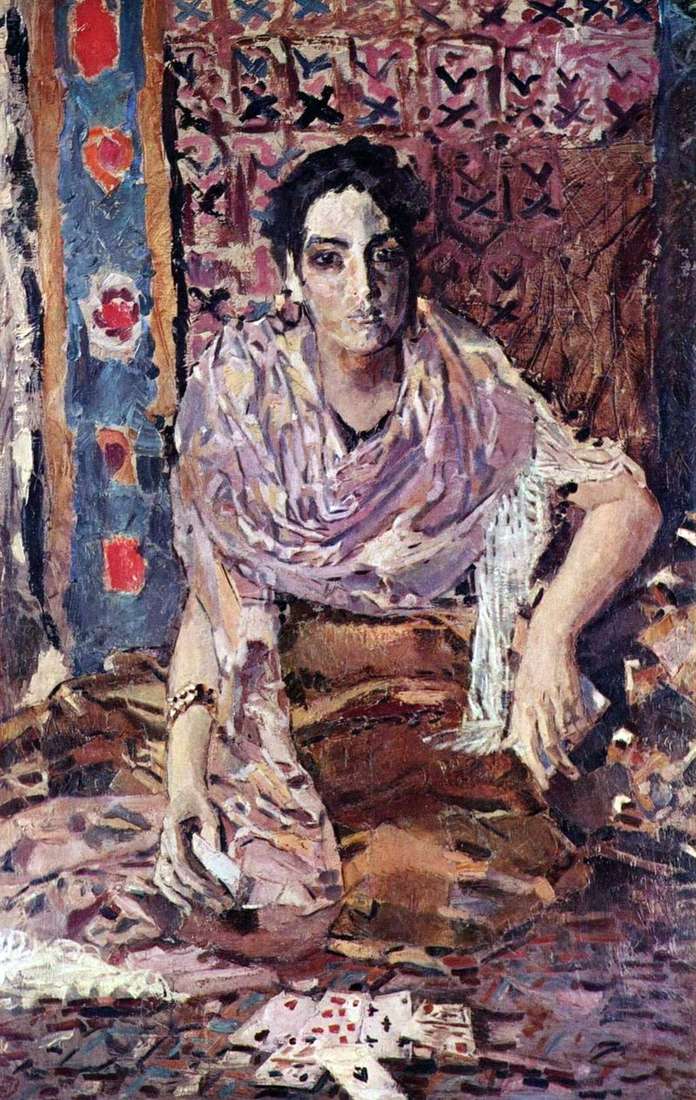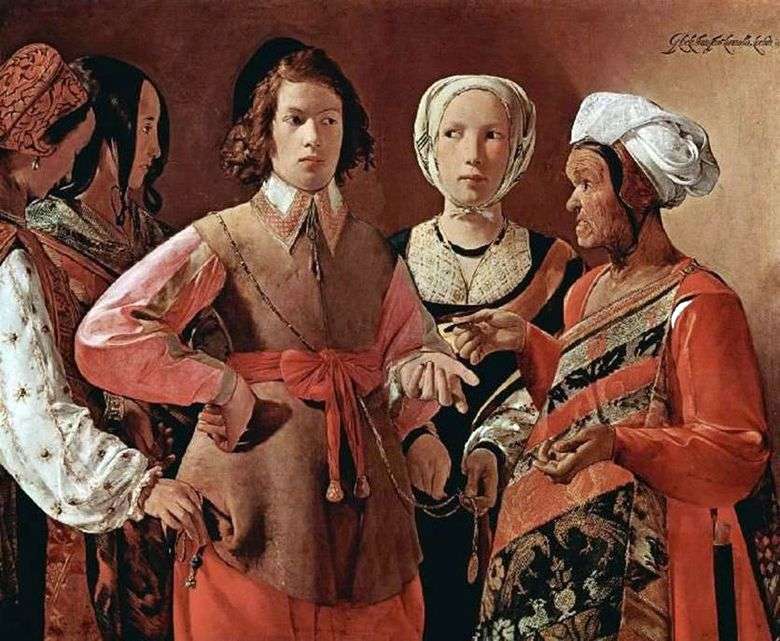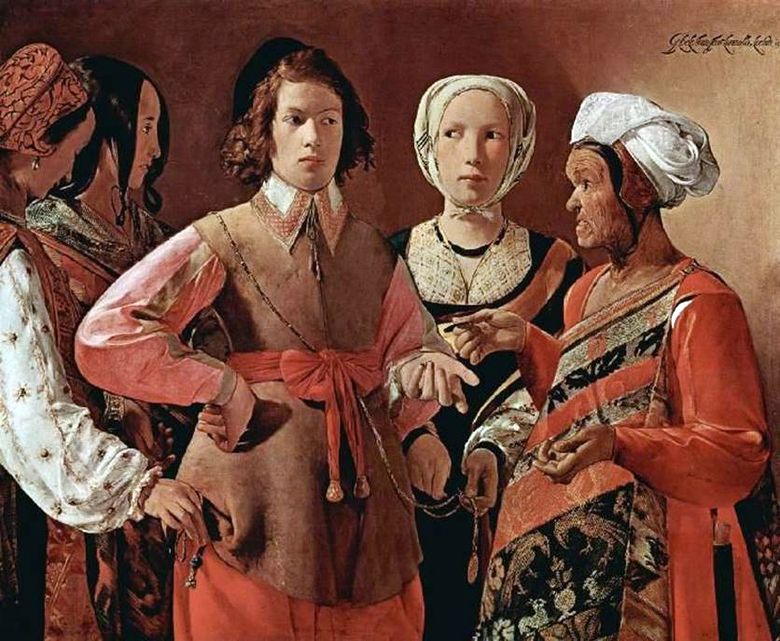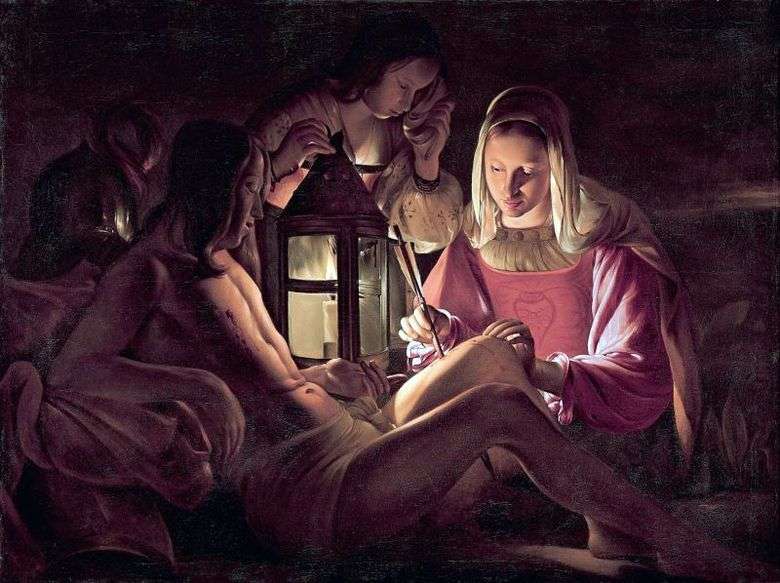
In spite of the young man’s leather military camisole, he still had a very childish face. He probably goes to college where rich parents sent their siblings until they reach the legal age of 15 years. The fortune teller and the two young girls to her left judging by their dark skin, black hair, and flowery color alongside – a gypsy woman. Two other paintings by Latour “Sharpie with an ace of diamonds” and “Sharpy with a club ace” depicted a similar situation.
The young man, in front of which lies a heap of gold coins, loses their trapped by a courtesan and a card sharper. Three paintings seem to be united by the biblical parable of the prodigal son went to the far side and there he squandered his estate, living dissolutely This parable from the Gospel of Luke was used by many artists of that time to depict drunkenness, fights and revelry. Latour seems more serious in comparison with them, he does not depict scenes of dissolute lifestyle. Not carelessness, but full concentration appears in the faces of the victim and the thieves in the picture. Divination and theft were dangerous occupation. A young man was expected, in the event of being caught, at best, a pair of lashes from the teacher, and at worst – excommunication. The thieves who stole the clock were cut off their ears, then branded, and could also be hung or quartered.
This picture, in which the characters are depicted so close to each other and at the same time so isolated, the artist wanted to warn against the cruel world in which a person is thrown, from a world of complete greed, selfishness and dangers lurking at every step. Golden glitters in the wrinkled hand of an old woman, a payment for her art and at the same time an essential attribute of the divination ritual. Before looking into the future, she draws a cross with them on a white, soft hand, which the young man so trustingly extended to her.
About this custom tells Presiosa – “Gypsy” from the novel of the same name by Cervantes, published in 1613. As for the crosses, all crosses are, of course, good, but gold or silver is much better; and if you make a cross on the palm with a copper coin, then keep in mind that it spoils your luck… mine at least the fortune-teller naturally received the gold used for this purpose and could even keep it for herself, while the rest of the spoils were written according to unwritten laws Gypsy camp was supposed to give a common pot. For example, a young man’s wallet or his commemorative coin, which is skillfully cut off from the chain by the delicate white beauty. She is at the same time, squinting, watching her victim. In action, only hands and avoiding each other or intersecting views. Tension arises from the contrast between seeming calm and latent activity, naivety and experience, the freshness of the faces of the girls and the wrinkled face of the old woman. It is on this tension that the plot of the canvas is built. Neither bright clothes, nor a fortune-teller coin in his hands distract from him. White gipsy stands out in particular.
This figure is a tribute to the myth popular in Western Europe about the abduction of Roma children from noble families. This story is often traced in European novels and plays. One detail in the picture indicates that the artist was familiar with the customs of the camp. Unmarried girls went uncovered; married women wore hair tucked under a cap or shawl, tied with a knot at the back of the head. A scarf, tied under the chin, like a beauty in the center of the picture, indicated that the girl was no longer a virgin, but also not married. Perhaps, it means that she is a “selling girl” at the fortune-teller-clerk. Maybe Latour portrayed theatrical characters, which would explain their unusually rich outfits for the Gypsies. They are dressed in costumes that do not correspond, in the opinion of all experts, to the fashion that existed in Lorraine in the 17th century.
 Fortune-teller by Michelangelo Merisi da Caravaggio
Fortune-teller by Michelangelo Merisi da Caravaggio The Fortune Teller by Caravaggio
The Fortune Teller by Caravaggio Fortune-teller by Mikhail Vrubel
Fortune-teller by Mikhail Vrubel St. Sebastien and the Holy Wives by Georges de La Tour
St. Sebastien and the Holy Wives by Georges de La Tour El adivino – Georges de La Tour
El adivino – Georges de La Tour Sharper with Ace of Diamonds by Georges de La Tour
Sharper with Ace of Diamonds by Georges de La Tour Diseuse de bonne aventure – Georges de La Tour
Diseuse de bonne aventure – Georges de La Tour San Sebastián y las santas esposas – Georges de La Tour
San Sebastián y las santas esposas – Georges de La Tour